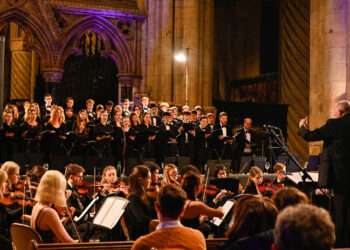 Usually when I go to a concert, I have some idea of what I might hear, and I can place the music within a mental and cultural framework that’s built up of my own listening experiences, and general knowledge about music. And if I get stuck, there are usually programme notes and The Internet to help me out. The music at DurhamKLANG17 pulled all that away from me, leaving me with just my ears, and the impressions it made on my mind; it’s a raw, elemental way to listen to music, and one that I don’t experience often enough. All this is a roundabout way of saying that I’m not properly equipped to write a very formal and precise review of tonight’s music, but as I hugely enjoy listening to and performing new music, I want to share something what I heard.
Usually when I go to a concert, I have some idea of what I might hear, and I can place the music within a mental and cultural framework that’s built up of my own listening experiences, and general knowledge about music. And if I get stuck, there are usually programme notes and The Internet to help me out. The music at DurhamKLANG17 pulled all that away from me, leaving me with just my ears, and the impressions it made on my mind; it’s a raw, elemental way to listen to music, and one that I don’t experience often enough. All this is a roundabout way of saying that I’m not properly equipped to write a very formal and precise review of tonight’s music, but as I hugely enjoy listening to and performing new music, I want to share something what I heard.
Tonight’s hour-long concert by E7B (Ensemble 7 Bridges), opening the three days of DurhamKLANG17, showcased music by four of Durham University’s post-graduate composition students, and one piece by Eric Skytterholm Egan, lecturer in composition. E7B is a collaboration between staff, students and players from Royal Northern Sinfonia, and is Durham’s contemporary ensemble in residence – this evening’s performers were John Snijders (piano), Emma Richards (viola) and Dov Goldberg (clarinet).
The opening piece, Millions of People Around the World by Jonathan Packham began with isolated sustained notes on the piano, creating an intense minimalist stillness, then gradually the fluttery vibrato of a string instrument joined in – I thought at first it was recorded, as I could hear every hair on the bow, until I realised that it was actually Emma Richards and her viola concealed in a tent on stage. The sparse texture built up with Snijder plucking the piano strings, and when the music eventually introduced two note chords, the introduction of a minimal harmony felt suddenly very warm.
On the Shore, at Midnight by Daryn Dawson-Jones was the most obviously descriptive piece of the evening. Massive and sustained piano cluster chords right down at the left-hand extremity of the keyboard immediately made me think of surf crashing on pebbles. Little fragments of melody came in, carefully placed against the fading reverberations of the big chord, so that the whole thing slipped back and forth between noise and beauty. Dov Goldberg and Emma Richards added additional colour with sustained tremolo notes (my baroque brain thinks the clarinet effect was maybe created with finger-vibrato) and harmonics, casting a pale light onto the waves.
An online Polish dictionary tells me that the title of Alice Stevenson’s solo piano piece Ozdoba | Złamać could mean something like “ornaments | breaking” and that certainly seems to fit with the music’s fragile, glittering fragments. This was a lively, spirited piece, with a real sense of fun going on, racing around bits of scales and teasing us with hints of almost familiar tunes. John Snijder’s absolute precision and detachment added fireworks to Stevenson’s hugely enjoyable piece.
Mark Carroll spoke briefly before the ensemble performed To my friend, the diner to explain that in this work, he was bringing his passion for folk music into a contemporary setting. He had based the piece on the traditional tune “Rosebud in June”, using a technique that goes back to some of the earliest Western harmonic music, stretching the original tune out way beyond recognition and building around it. The clarinet and viola held serenely long, sustained notes, while the piano part pottered around them, adding sprinkles of colour. The warm tones of the viola and clarinet worked particularly well together in this piece, creating warm, sonorous harmonies.
Eric Skytterholm Egan’s North Korea is the first part of a cycle titled “Conflict as Artefact”, in which the composer uses remnants from forgotten conflicts as a starting point to create new art –in this instance, photos of bomb craters from the Korean war. He spoke briefly about the moral challenges he faces in taking the ugliness of human suffering to make something new; he was at pains to point out that his music is not trying to illustrate the North Korean bomb craters, or to say anything about the conflict that caused them, he’s merely taking them as a starting point, using their shapes to shape his score – we were given copies so we could see his idea. The piece itself was incredibly quiet, full of little trills and glissandi, with both viola and clarinet using extended techniques in Egan’s ghostly, half-glimpsed sound-world: Emma Richards creating a very tender sound by bowing on the neck of her viola, right up near the fingerboard; Dov Goldberg using (I think) varying breath pressure to create clarinet harmonics.
There are two more concerts in the DurhamKLANG17 festival, and they’re both free: give it a go, you have nothing to lose but your chains (or something).









